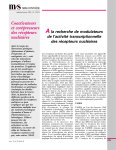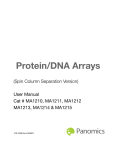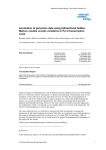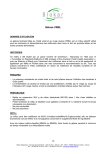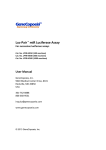Download Troubleshooting affinity chromatography
Transcript
Immunoaffinity Purification: Affinity chromatography Troubleshooting affinity chromatography Problem: Tagged protein appears in washes, does not bind to affinity resin Possible cause Remedy Antibody did not couple to support resin Try another method to couple the antibody to the resin. Use a different chemical technique to couple the antibody to the resin. For example, couple the antibody through its carbohydrate groups (hydrazide coupling) rather than through its amino groups. Do trial experiments to optimize loading parameters. Follow these general guidelines: Antibody binding site altered or blocked during antibody-resin coupling procedure; cannot bind tagged protein One or more of these sample loading conditions may not be optimal for binding tagged protein to affinity column: • pH • Flow rate • Temperature • Salt or ion concentration Proteases are degrading tagged protein Antibody on affinity column was inactivated during prior use Channels have formed in column bed so loaded sample runs through column without interacting with antibody • Load at neutral pH. • Load sample slowly or use batch loading. • Load at room temperature. • Salt and ion concentration in Binding Buffer should be kept low. Add protease inhibitors (BM) to sample loading/wash buffer. Note: See Section 4B of this manual for more information on protease inhibitors. Always wash column with Binding Buffer right after each use. Always store column at 4°C in Binding Buffer + Azide. Prepare a new column. Re-pack column. Problem: Tagged protein remains bound to column, does not elute in Elution Buffer. 4C 4.12 Possible cause Remedy Elution Buffer is not optimal Try alternative elution buffers, such as described in Procedure II. Try a combination of the elution buffers described in Procedure II. Try elution at a higher temperature. CONTENTS Immunoaffinity Purification: Affinity chromatography Problem: Extra proteins in eluant with tagged protein Possible cause Remedy Nonspecific proteins binding to affinity resin Before applying sample the first time, block the resin with a protein that will not later interfere with the chromatography, for instance, bovine serum albumin. After sample application, wash column more thoroughly before eluting tagged protein. Wash columns with a more stringent second Wash Buffer (for example, with higher salt). Apply sample in a Binding Buffer containing enough salt to minimize nonspecific binding (but not the binding of the tagged protein). Problem: Tagged protein degraded Possible cause Remedy Proteases in sample Include protease inhibitors throughout procedures. Work at low temperature, such as 4°C, to minimize degradation. Work at low temperature, such as 4°C, to minimize degradation. Tagged protein unstable Problem: Bubbles in affinity column Possible cause Remedy Column poured and stored at one temperature, but used at another Always allow column to equilibrate to procedure temperature, then degas under vacuum and remix resin to remove bubbles before using. OR Pour column at the same temperature that it will be used. OR Pour column at a warmer temperature, then let it equilibrate to a cooler temperature. Use the column at the cooler temperature. 4C Problem: Tagged protein elutes as a diffuse band Possible cause Remedy Elution Buffer does not immediately release protein from resin Elution causes band diffusion Increase concentration of release agent (peptide, salt, etc.) in Elution Buffer. Use reverse (upward) flow to elute the column. (Note: requires mechanical pump to create upward flow.) CONTENTS 4.13 Immunoaffinity Purification: Affinity chromatography Suggested reading to learn more about procedure There are numerous affinity purification protocols described in the literature. For a detailed description of these techniques and discussion of factors affecting the results, see Hermanson, Mallia and Smith (1992). Other helpful references include Cuatrecases, Wilchek and Anfinsen (1968); Dean, Johnson and Middle (1985); Harlow and Lane (1988); and Wilchek, Miron and Kohn (1984). References Cuatrecasas, P., Wilchek, M. and Anfinsen, C.B. (1968) Selective enzyme purification by affinity chromatography. Biochemistry 61:636–43. Dean, P.D.G., Johnson, W.S. and Middle, F.A. (1985) Affinity Chromatography: A Practical Approach. IRL Press. Field, J., Nikawa, J.-I., Broek, D., MacDonald, B., Rodgers, L., Wilson, I.A., Lerner, R.A. and Wigler, M. (1988) Purification of a RAS-responsive adenylyl cyclase complex from Saccharomyces cerevisiae by use of an epitope addition method. Mol. Cell. Biol. 8 (5): 2159–2165. Frost, R.G., Monthony, J.F., Engelhorn, S.C. and Siebert, C.J. (1981) Covalent immobilization of proteins to N-Hydroxysuccinimide ester derivatives of agarose: Effect of protein charge on immobilization. Biochim. Biophys. Acta 670 (2):163–169. Harlow, E. and Lane, D. (1988) Antibodies: A Laboratory Manual. Cold Spring Harbor (N.Y.) Press. Hermanson, G.T., Mallia, A.K. and Smith, P.K. (1992) Immobilized Affinity Ligand Technologies. Academic Press. O’Shannessy, D.J. and Hoffman, W.L. (1987) Sitedirected immobilization of glycoproteins on hydrazide-containing solid supports. Biotech Appl. Biochem. 9 (5):488–496. Prickett, K.S., Amberg, D.C. and Hopp, T.P. (1989) A calcium-dependent antibody for identification and purification of recombinant proteins. BioTechniques 7 (6):580–589. Templeton, D.J. (1992) Nuclear binding of purified retinoblastoma gene product is determined by cell cycle-regulated phosphorylation. Mol. Cell. Biol. 12 (2):435–443. Wilchek, M., Miron, K.T. and Kohn, J. (1984) Affinity chromatography. Methods Enzymol. 104:3–55. 4C Zhou, Q., Lieberman, P.M., Boyer, T.G. and Berk, A.J. (1992) Holo-TFIID supports transcriptional stimulation by diverse activators and from a TATA-less promotor. Genes and Development 6 (10): 1964–1974. 4.14 CONTENTS



